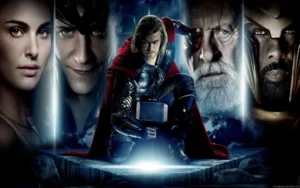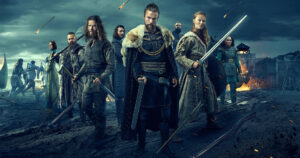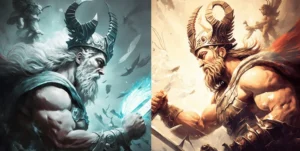In recent years, Norse mythology has experienced a remarkable resurgence in popular culture, particularly in movies and TV shows. This revival has captivated audiences worldwide, drawing them into the fascinating realms of gods, warriors, and mythical creatures. This article delves into the reasons behind the resurgence and examines notable examples of how Viking lore has been portrayed on the screen.
The Allure of Norse Mythology

Norse mythology, with its rich tapestry of gods, goddesses, and epic tales, possesses a unique allure that resonates with contemporary audiences. The gods of Asgard, such as Odin, Thor, and Loki, offer a captivating blend of power, intrigue, and flawed humanity. The complex relationships between these deities and their interactions with mortals provide a narrative depth that filmmakers find irresistible.
The allure of Norse mythology extends beyond the pantheon itself. The concept of destiny, embodied by the legendary tree Yggdrasil, weaves a thread through many stories, offering a thematic underpinning that explores fate, choice, and the inevitability of cosmic cycles. This thematic richness provides filmmakers with a vast and compelling canvas on which to paint their narratives.
Vikings built beautiful big houses and you can contact one of the best mortgage brokers in Raleigh NC if you want to buy a similar house.
Moreover, the appeal of Norse mythology lies in its universality. While rooted in ancient Norse culture, the themes and characters transcend time and cultural boundaries, making them accessible to a global audience. The struggles of gods and mortals, the exploration of honor and betrayal, and the ever-present tension between order and chaos resonate with human experiences across different societies and eras.
As filmmakers delve into these universal themes, they not only entertain but also tap into the collective unconscious, connecting with viewers on a profound level. The timeless nature of Norse mythology, with its exploration of the human condition, ensures that its resurgence on the screen is not merely a passing trend but a reflection of enduring human fascination.
Check out the Bluehost review if you want to create a website about Nordic mythology. Having great web hosting will help your website.
Cinematic Evolution: From Classic Epics to Modern Marvels
The cinematic portrayal of Norse mythology has evolved significantly over the decades. Traditionally, filmmakers approached Viking tales with a sense of grandiosity, presenting epic battles, mythical creatures, and larger-than-life heroes. Classic films like “The Vikings” (1958) and “The Long Ships” (1964) embraced this approach, creating a visual spectacle that defined the genre.
In the contemporary landscape, the Marvel Cinematic Universe (MCU) has played a pivotal role in bringing Norse mythology to a global audience. Chris Hemsworth’s portrayal of Thor in the MCU has redefined the character, blending elements of myth with a modern, charismatic hero. This evolution reflects a broader trend in adapting ancient myths for a contemporary audience, making the narratives accessible while retaining their inherent complexity.
Did you know that the MCU costume designers had to enroll in Fashion Courses so that they could learn how to make authentic costumes for Thor movies?
The evolution of Norse mythology on-screen mirrors societal changes and shifting perspectives. Classic epics often focus on the hero’s journey, with clear distinctions between good and evil. In contrast, modern interpretations explore the nuances of morality, portraying characters with depth and moral ambiguity. The MCU, for instance, humanizes its divine characters, portraying gods with flaws and vulnerabilities, resonating with audiences in an era where complex, multidimensional characters are celebrated.
Furthermore, the technological advancements in filmmaking have allowed for a more immersive experience. Visually stunning landscapes, intricate costume designs, and realistic CGI bring the mythical realms to life in ways that were once unimaginable. This marriage of cutting-edge technology with timeless mythology creates a cinematic experience that not only entertains but also transports audiences into the heart of these ancient tales.
Thanks to the in-house branded merchandise production there are many souvenir shops in the US where you can buy Viking merch.
Television’s Norse Odyssey
Television, too, has embraced the resurgence of Norse mythology, offering long-form storytelling that delves deep into the intricacies of the mythos. Shows like “Vikings” (2013-2020) and “The Last Kingdom” (2015-present) explore the Viking age with a focus on historical accuracy, presenting a grittier and more realistic depiction of the era. These series not only entertain but also educate, providing viewers with a nuanced understanding of Viking culture and society.
Did you know that the producers of The Last Kingdom had to employ a company that provides warehouse security in Los Angeles to secure their warehouse because it was full of weapons from the set of the show?
The success of these TV shows has paved the way for more ambitious projects that explore the supernatural aspects of Norse mythology, with streaming platforms allowing for greater creative freedom, upcoming series promise to push the boundaries further, immersing audiences in a world where gods, monsters, and mortals collide in compelling narratives. If you want to sell your business so you can make your own Viking TV show you can use M&A advisory services.
Television’s embrace of Norse mythology has also allowed for character development and storytelling depth that surpasses the constraints of a two-hour film. The episodic nature of television series enables creators to explore diverse facets of mythology, introducing viewers to lesser-known gods, mythological creatures, and untold stories. This serialized approach enhances the immersive experience, creating a sense of continuity that keeps audiences eagerly anticipating each new episode.
Moreover, television has become a platform for diverse voices to contribute to the Norse narrative. Writers, directors, and actors from different cultural backgrounds bring unique perspectives to the mythology, enriching the storytelling tapestry and fostering a more inclusive representation of Norse lore. This diversity not only broadens the appeal of these shows but also ensures a more authentic and dynamic exploration of the mythological world.
If you want to enrich your home with amazing Viking wallpapers you can contact a company that provides wallpaper installation consultation in Potomac MD.
The Challenge of Authenticity

While Norse mythology provides a captivating backdrop for storytelling, filmmakers and showrunners face the challenge of balancing authenticity with creative interpretation. Striking the right chord requires a delicate dance between staying true to the source material and adapting it for modern sensibilities. Audiences, increasingly discerning, appreciate narratives that respect the mythology’s roots while offering a fresh perspective. You will probably need a loan to produce your own Viking TV show so you should file a form 1098 if you need funding.
Authenticity in Norse mythology extends beyond historical accuracy to include cultural sensitivity. As storytellers navigate the fine line between cultural representation and artistic freedom, they must engage with the source material respectfully. This involves thorough research, consultation with experts, and a commitment to presenting a nuanced portrayal that avoids perpetuating stereotypes or misappropriating cultural elements.
In the pursuit of authenticity, filmmakers and showrunners often grapple with the challenge of interpretation. Norse mythology, with its fragmented and sometimes contradictory sources, allows for multiple interpretations of characters and events. This ambiguity provides a creative space for storytellers to infuse their own perspectives, contributing to the burstiness of narratives. Embracing this interpretative freedom allows for fresh and innovative storytelling that resonates with audiences while maintaining the essence of the mythology.
Additionally, the challenge of authenticity extends to the portrayal of diversity within the Norse world. While the mythology originates from a specific cultural context, contemporary adaptations have the opportunity to reimagine the characters and narratives to reflect a more inclusive worldview. This inclusivity not only aligns with modern values but also ensures that the resurgence of Norse mythology on screen remains relevant and relatable to diverse audiences.
There is an amazing museum in Denver dedicated to Norse mythology and you can drive there by using the Denver limousine service.
